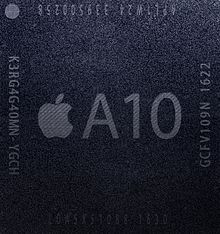 | |
| General information | |
|---|---|
| Launched | September 7, 2016 |
| Discontinued | May 10, 2022 |
| Designed by | Apple Inc. |
| Common manufacturer | |
| Product code | APL1W24 |
| Max. CPU clock rate | to 2.34 GHz[2] |
| Cache | |
| L1 cache | Per core: 64 KB instruction + 64 KB data |
| L2 cache | 3 MB shared |
| L3 cache | 4 MB shared |
| Architecture and classification | |
| Application | Mobile |
| Technology node | 14 nm (16FFC) |
| Microarchitecture | "Hurricane" and "Zephyr" |
| Instruction set | ARMv8.1-A: A64, A32, T32 |
| Physical specifications | |
| Transistors |
|
| Cores |
|
| GPUs | Custom PowerVR Series 7XT GT7600 Plus (hexa-core, internal name - Apple G9) [3][4] |
| Products, models, variants | |
| Variant | |
| History | |
| Predecessors | Apple A9 (iPhone) Apple A9X (iPad) |
| Successor | Apple A11 Bionic |
The Apple A10 Fusion is a 64-bit ARM-based system on a chip (SoC) designed by Apple Inc., part of the Apple silicon series, and manufactured by TSMC. It first appeared in the iPhone 7 and 7 Plus which were introduced on September 7, 2016,[5][6] and is used in the sixth generation iPad, seventh generation iPad, and seventh generation iPod Touch. The A10 is the first Apple-designed quad-core SoC, with two high-performance cores and two energy-efficient cores. Apple states that it has 40% greater CPU performance and 50% greater graphics performance compared to its predecessor, the Apple A9. The Apple T2 chip is based on the A10.[7] On May 10, 2022, the iPod Touch 7th generation was discontinued, ending production of A10 Fusion chips.[8] The latest software updates for the iPhone 7 & 7 Plus including the iPod Touch 7th generation variants systems using this chip are iOS 15.8.3, released on July 29, 2024, as they were discontinued with the release of iOS 16 in 2022, while updates for the iPad 7th generation variant systems using this chip are still supported.
- ^ Cite error: The named reference
chipworkswas invoked but never defined (see the help page). - ^ Cunningham, Andrew (September 13, 2016). "iPhone 7 and 7 Plus review: Great annual upgrades with one major catch". Ars Technica. Archived from the original on September 13, 2016. Retrieved September 14, 2016.
- ^ "iPhone 7 GPU breakdown". Wccftech. December 2016. Archived from the original on 2016-12-05. Retrieved 2017-02-01.
- ^ "Mysteries of Apple A10 GPU". PC World. December 2016. Archived from the original on 2017-01-28. Retrieved 2017-02-01.
- ^ "Apple Debuts Three Custom Chips - EE Times". EETimes. Archived from the original on 2016-09-08. Retrieved 2016-09-07.
- ^ Smith, Ryan. "Apple Announces iPhone 7 & iPhone 7 Plus: A10 Fusion SoC, New Camera, Wide Color Gamut, Preorders Start Sept. 9th". Anandtech. Archived from the original on 2016-09-09. Retrieved 2016-09-07.
- ^ "Hackers claim they can now jailbreak Apple's T2 security chip". ZDNET. October 6, 2020. Archived from the original on May 6, 2021. Retrieved May 21, 2021.
- ^ "Apple discontinues iPod touch, ending 20 year run of iconic 'iPod' brand". 9to5Mac. May 10, 2022. Archived from the original on May 10, 2022. Retrieved May 10, 2022.